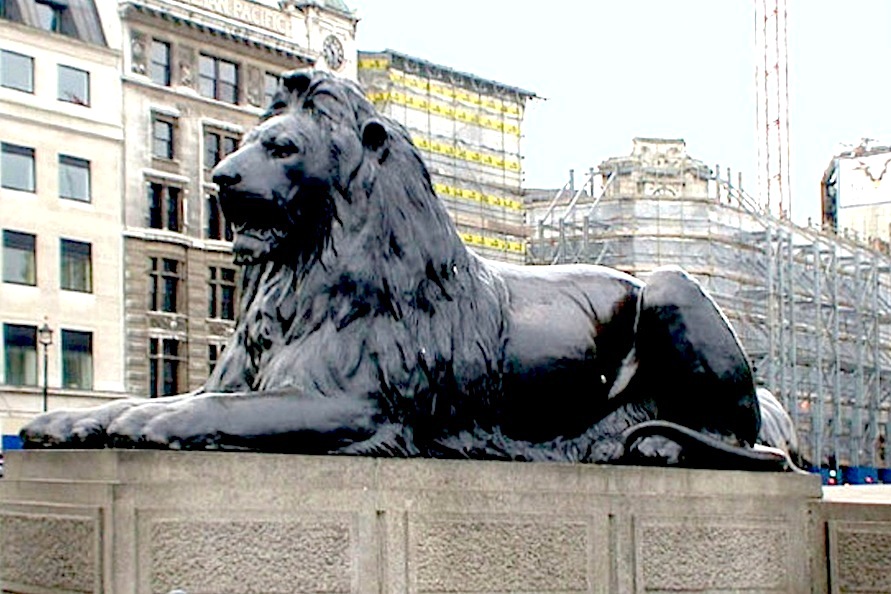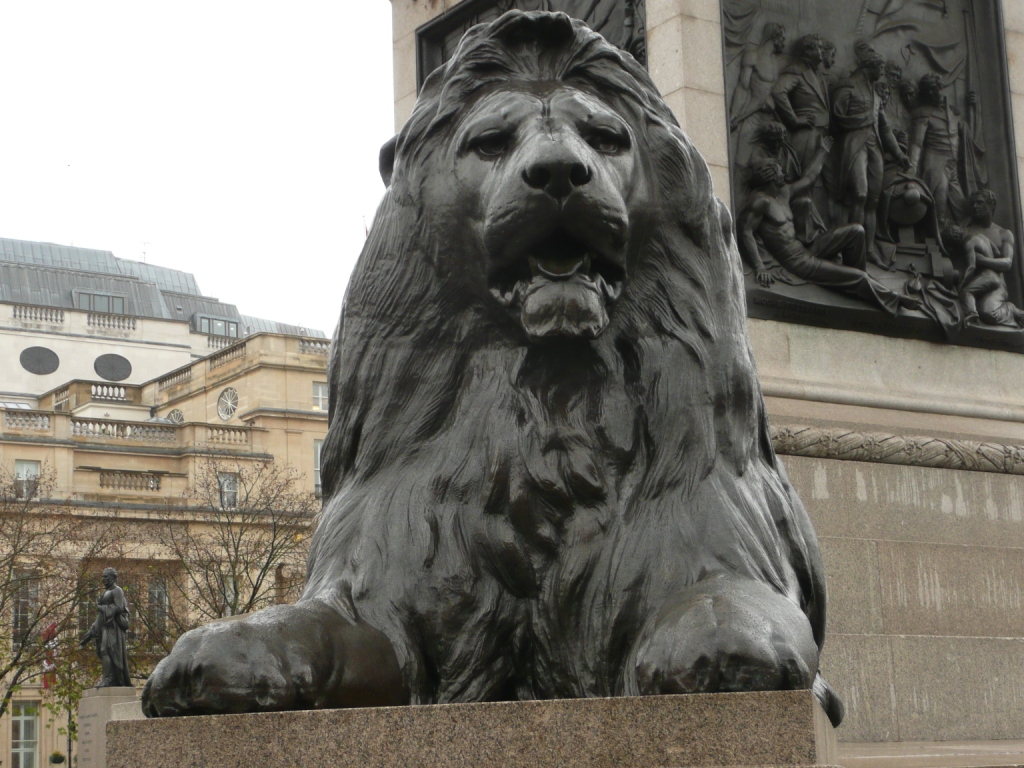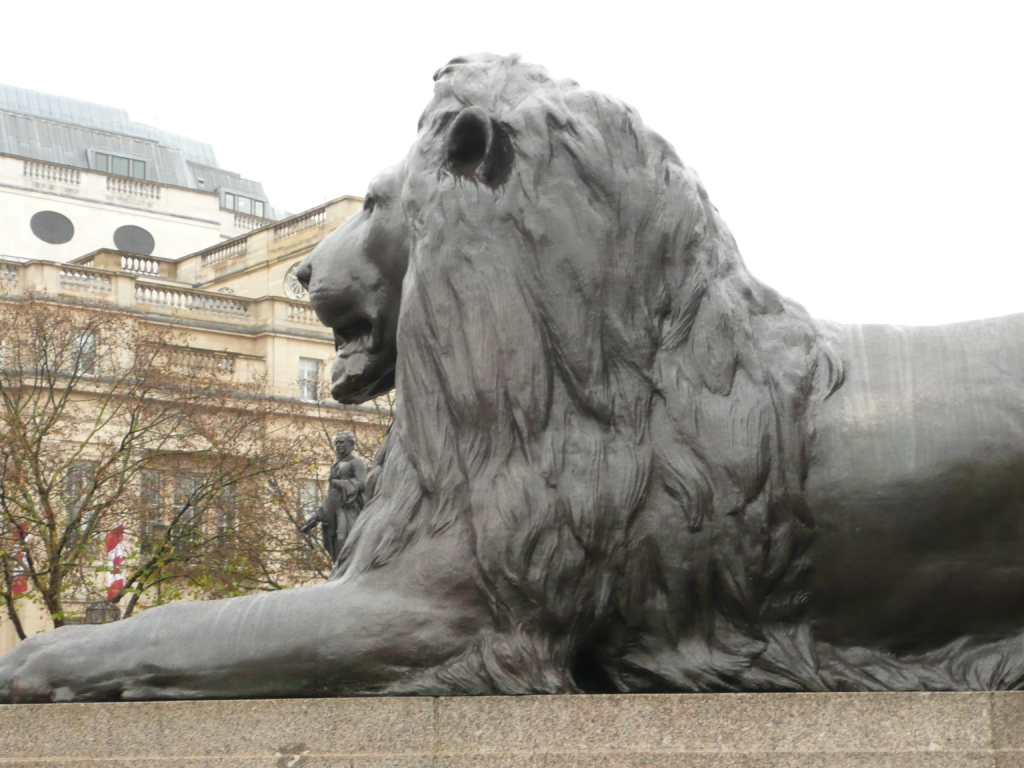Sir Edwin Landseer's Lions at the Base of Nelson's Column, Trafalgar Square
Jacqueline Banerjee. PhD, Associate Editor, the Victorian Web
[Victorian Web Home —> Visual Arts —> Sculpture —> Sir Edwin Henry Landseer, RA —> Next]

One of the four lion sculptures by Sir Edwin Landseer (1802-73) at the base of Nelson's Column, Trafalgar Square. This is the lion on the south west angle, as seen from the busy road between the Strand and Pall Mall. There are practically (but not completely) identical lions on the rectangular plinths at the base of all four corners. Each is 20 feet long and 22 feet high, differing from the others only in tiny details (the flow of the mane, perhaps a slight angle of the head). Representing the "largest and most taxing commission with which Landseer was involved" (Ormond 21), they were all cast by Baron Marochetti and finally placed in position in 1867.


Left: Lion on the south east, with the Canadian Pacific building in the background. Right: Close-up of the lion's face, from the front.


Left: The front of the lion on the south west again, with Canada House in the background. Right: The same lion, full face (compare its face and mane with those of the south-east lion; this one seems to be looking slightly to its right).
Contributor Chris Bell, who has photographed the lions from matching viewpoints, confirms that the lions are hard to tell apart, and adds, "The other thing that is very apparent is the truth in the statement that Landseer gave up with paws because the dead lion he obtained from Regent's Park zoo had rotted before he got as far as modelling that part of its anatomy." In all these respects, Landseer's creatures contrast markedly with the lions originally designed for Trafalgar Square by Thomas Milnes. These are highly differentiated stone sculptures in naturalistic poses, detailed in all points. They also vividly represent the different virtues associated with Nelson; yet the models were not considered suitable and in the end the commission was given to the famous animal-painter. Milnes's lions, their final versions considerably smaller than Landseer's ("only" eight feet long), went to Titus Salt's model mill village, Saltaire in Yorkshire, instead.
Thomas Milnes's Lions




Milnes's lions. Left to right: (a) Peace. (b) War. (c) Determination. (d) Vigilance.
At the time, Landseer's lions were praised by his friends; but they had their critics (see Ormond 21). "The hair of the lions looks like streaming water; it has no mass, no vigour of light and shade," complained a commentator in the Every Saturday periodical. "[E]ven worse," this critic continued, each lion "exhibits hardly any relation to the structure which supports it" (345). Nevertheless, posterity has now cast its vote and the great bronze beasts at the foot of Nelson's Column have become iconic, as nature-writer Richard Jefferies' lyrical account of them suggests.
Excerpt from Jefferies' "The Lions of Trafalgar Square"

The lion on the north-east angle, with the National Gallery in the background.
The lions in Trafalgar Square are to me the centre of London by those lions began my London work; from them, as spokes from the middle of a wheel, radiate my London thoughts. Standing by them and looking south you have in front the Houses of Parliament, where resides the mastership of England; at your back is the National Gallery — that is art; and farther back the British Museum — books. To the right lies the wealth and luxury of the West End; to the left the roar and labour, the craft and gold, of the City. For themselves, they are the only monument in this vast capital worthy of a second visit as a monument. Over the entire area covered by the metropolis there does not exist another work of art in the open air. There are many structures and things, no other art. The outlines of the great animals, the bold curves and firm touches of the master hand, the deep indents, as it were, of his thumb on the plastic metal, all the technique and grasp written there, is legible at a glance. Then comes the pose and expression of the whole, the calm strength in repose, the indifference to little things, the resolute view of great ones. Lastly, the soul of the maker, the spirit which was taken from nature, abides in the massive bronze. These lions are finer than those that crouch in the cages at the Zoological Gardens; these are truer and more real, and, besides, these are lions to whom has been added the heart of a man. Nothing disfigures them; smoke and, what is much worse, black rain — rain which washes the atmosphere of the suspended mud — does not affect them in the least. If the choke-damp of fog obscures them, it leaves no stain on the design; if the surfaces be stained, the idea made tangible in metal is not. They are no more touched than Time itself by the alternations of the seasons. The only noble open-air work of native art in the four-million city, they rest there supreme and are the centre. Did such a work exist now in Venice, what immense folios would be issued about it! All the language of the studios would be huddled together in piled-up and running-over laudation, and curses on our insular swine-eyes that could not see it. I have not been to Venice, therefore I do not pretend to a knowledge of that mediæval potsherd; this I do know, that in all the endless pictures on the walls of the galleries in London, year after year exposed and disappearing like snow somewhere unseen, never has there appeared one with such a subject as this. Weak, feeble, mosaic, gimcrack, coloured tiles, and far-fetched compound monsters, artificial as the graining on a deal front door, they cannot be compared; it is the gingerbread gilt on a circus car to the column of a Greek temple. This is pure open air, grand as Nature herself, because it is Nature with, as I say, the heart of a man added. [321-23]
Related Material
- John Ballantyne's oil-painting of Landseer at work on the lions in Marochetti's studio
- The four lions by Thomas Milnes, originally intended for Trafalgar Square
- A table showing the two sets of lions
- Punch's “The Lions at last!”
- E. H. Baily's statue of Nelson
- Trafalgar Square
The three photographs of Landseer's lions shown full-length, are by the author>. The photographs of the front parts of some of Landseer's lions, and of all Thomas Milnes's lions, were kindly contributed by Chris Bell. The excerpt from Richard Jefferies' essay has been added by George P. Landow. [You may use these images without prior permission for any scholarly or educational purpose as long as you (1) credit the photographer and (2) link your document to this URL or cite the Victorian Web in a print document. Click on all the pictures to enlarge them.]
Bibliography
Jefferies, Richard. "The Lions of Trafalgar Square." In The Toilers of the Field. London: Longmans, 1892. 321-27. Internet Archive. Contributed by the University of California. Web. 29 September 2011.
Ormond, Richard. Sir Edwin Landseer: Catalogue of an exhibition, Philadelphia Museum of Art, Oct. 24, 1981-Jan. 3, 1982, and the Tate Gallery, London, Feb. 10-Apr. 12, 1982. Available on the Internet Archive. Web. 4 December 2015.
Last modified 4 December 2015